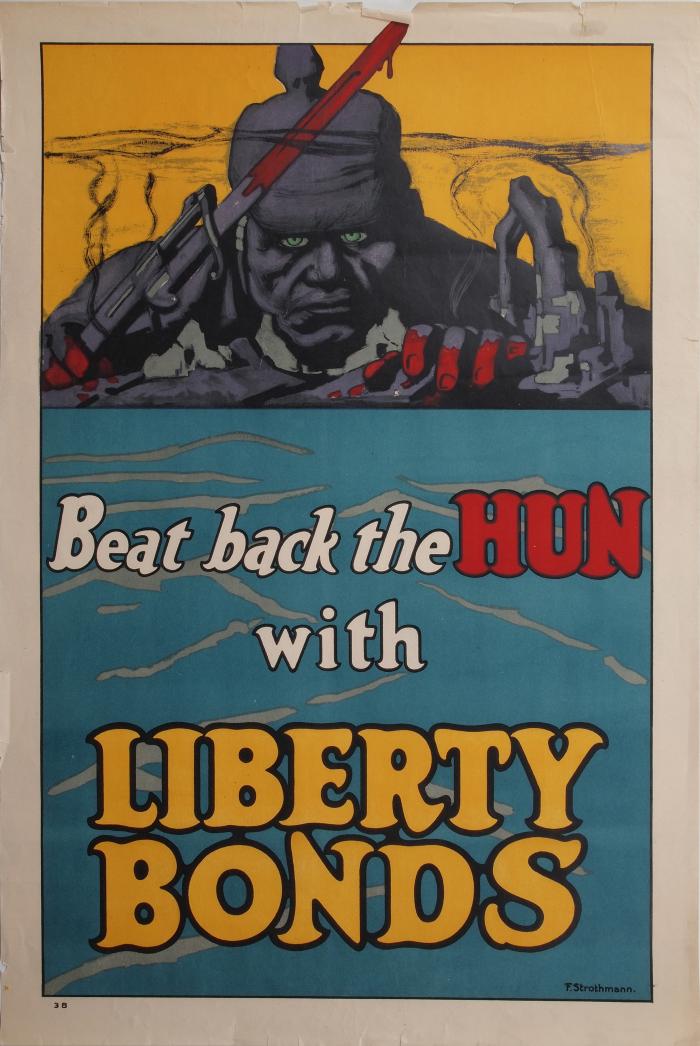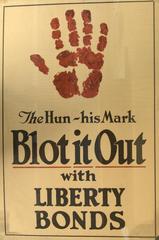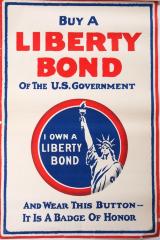Comments and Tags
Be the first to comment on this item!
Posters
Military and Veterans ➔ Poster, Beat Back The Hun
Identifier:
136632Description:
Bold color poster of a bloodied fingered, green eyed hun carrying a rifle with bloodied bayonet peering across smoky ruins and a body of water. Beat back the Hun with LIBERTY BONDS printed across the body of water. Bottom right hand corner bears signature F. Strothmann. Bottom left corner beneath artwork has 3B inscribed. Poster has 1.5 inch white/cream border around image with bloodied bayonet breaking into border.The poster “Beat Back the Huns,” created by Frederick Strothman in 1918, was utilized by the United States Treasury Department to encourage Americans to buy Liberty Loan bonds. These securities were used to finance the war, and provided an opportunity for non-combatants to contribute to the effort. Initially the interest rate was so low that people did not invest in them. This prompted a large amount of sensationalistic propaganda from the government in order to convince the public that buying bonds was both patriotic and a way of saving America and Europe from enemy forces. It worked; over 50% of American families finally bought war bonds by the end of the war. This poster’s portrayal of a German as a Hun, complete with Attila the Hun’s helmet, was a common message used to propagate the notion that Germans were barbaric and brutal. Huns were an ancient Central Asian people group who were famous for their deadly raids, but Germans are neither their ethnic nor their cultural descendents. This nickname originated due to German Kaiser Wilhelm II’s 1900 speech when he dispatched his troops to China during the Boxer Rebellion. He urged his army to “strike fear into the hearts [of the Chinese], so [Germans would] be feared like the Hun.” This made for ideal propaganda material during World War One, when Great Britain and later the U.S. needed fodder to motivate their people against Germany. Along with the nickname came a slew of false stories and exaggerations of German brutality, which is alluded to by this poster’s depiction of a dark and bloody German standing over a ravaged European city.
Date:
circa 1918Materials:
PaperCurrent Location Status:
In StorageSource:
Museum CollectionExhibits/Programs:
Newcomers: The People of this Place (after 2008)I Want You - World War One Posters (July 1 2014 – December 21 2015)
The years 1914-1918 mark the centenary of World War I, the most devastating global war in history. In the United States alone, over 4,000,000 military personnel were mobilized with 110,000 deaths. Virtually everyone was affected by the war in some way. In recognition of this important event in history, GRPM has selected posters from its permanent collection that demonstrate important issues at the heart of the war efforts.
Posters were a central way for the government to communicate with the public during World War I. The major themes of the posters were: patriotism and justifying the war, the recruitment of men and women for military and labor forces, raising money and resources as well as managing standards of behavior during a time when life was highly unpredictable. Through creative and symbolic graphics with bold messages, posters were considered a force in gaining support and uniting the public in the wartime efforts.
As you view these posters, reflect on the methods employed in creating them. How do the fonts, the word choice and images reinforce the intended message? Do these posters evoke a mood or emotion? Do any of the ideas in these posters conflict with the social and cultural norms of the time?


